This short clip is the opening sequence of ‘How Many People See The Stars As I Do? The Exmoor Story of Hope Bourne’. Chris Chapman’s 50 minute documentary explores the extraordinary life and talent of Exmoor’s legendary figure, the artist and writer, Hope Bourne. Hope led a life of self-sufficiency in a tiny caravan in remote isolation in the ruins of a farm on Exmoor for some 24 years and spent much of her time painting and sketching the moor, writing a column for the local paper, and combining this creativity in a remarkable series of books. There is more you can read about her here: A Wild Woman of Exmoor.
Recent Updates
Juliette of the Herbs
A preview of a documentary about the life and work of Juliette de Bairacli Levy: world renowned herbalist, author, breeder of Afghan hounds, friend of the Gypsies, traveller in search of herbal wisdom and the pioneer of holistic veterinary medicine. For more than 60 years Juliette has lived with the Gypsies, nomads and peasants of the world, learning the healing arts from these peoples who live close to nature. Juliette’s well-loved and now classic herbals for animals and for children have been a vital inspiration for the present day herbal renaissance and holistic animal care community.
Kukeri: Dancing Evil Spirits Away
Once a year, the Bulgarian tradition of Kukeri unites a small village as residents wear intricate masks and costumes and dance at night. Killian Lassablière chronicles the practice in his short documentary.
A New Yorker Documentary.
https://www.newyorker.com/video/watch/the-new-yorker-documentary-kukeri-dancing-evil-spirits-away
Seven-sided sigils and 21
Many of the Sareoso diagrams incorporate seven-sided sigils, shapes made by connecting seven points equally spaced around a circle in different ways. The diagrams below shows three of the simplest shapes, which I call the three mothers:
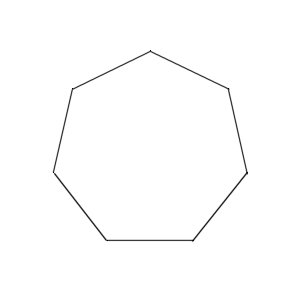
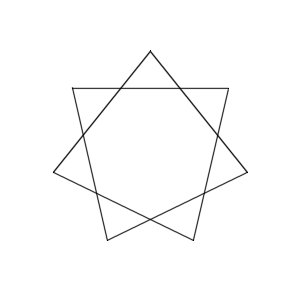
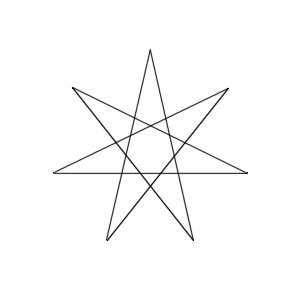
As you can see, the three are made by spacing out the points that one line joins together. In the first diagram, two adjacent points are joined, in the second one there is a gap of one point, and in the third one a gap of two points. If we were to carry on, leaving a gap of three points, we’d find the shape would be the same, but drawn backwards.
There’s an interesting effect when we superimpose all three diagrams. We get a seal made of 21 connections.
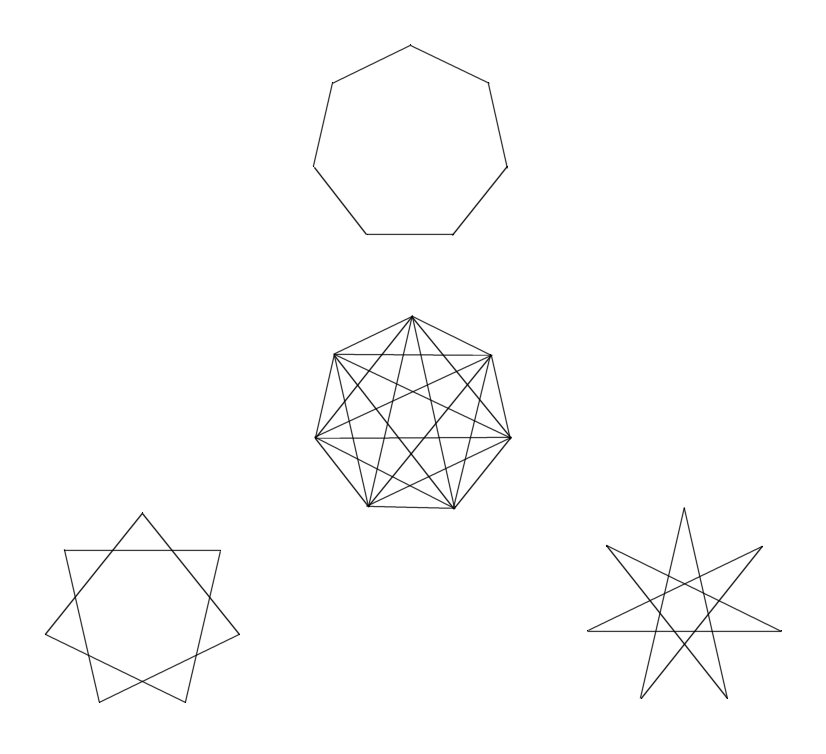
Looking at the seal you can see that each point is connected to the six other points in the circle. Seven points connected to 6 other points gives 7×6=42 ways of going between points, but because each path is counted forwards and backwards, the total number of connections is 42÷2 = 21.
This connection of the three sigils with the 21 is hinted at in diagrams 14 and 22.
If you want to draw your own seven-sided sigils, you can use the construction method hinted at in diagrams 12 and 13 to make a quite accurate seven-sided shape (heptagon), using the approximation attributed to Albrecht Dürer. The method is described here:
The Wheel of Life
Everything that is has a cause which drives the wheel of life…
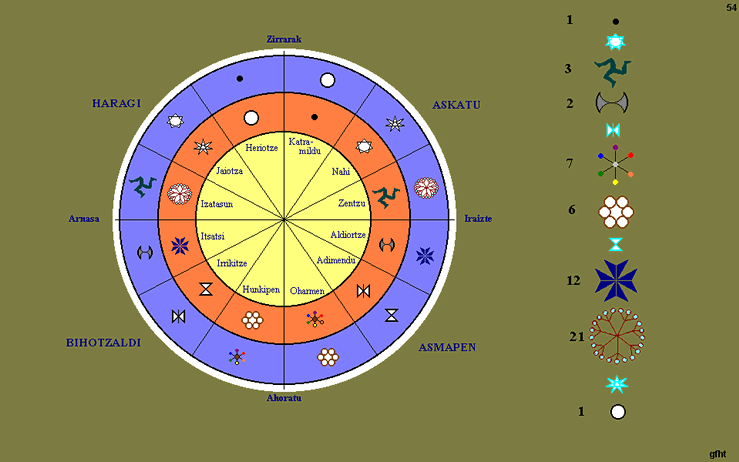
Many of the Sareoso diagrams include a cycle of twelve links with some similarity to the Buddhist “Wheel of Life”. This wheel embodies the view that every event is caused by something and results in something else. One example of this wheel is found in Diagram 54, where the 12 steps are labelled as follows.
| KATRAMILDU | Ignorance |
| NAHI | Will |
| ZENTZU | Consciousness |
| ALDIORTZE | Time & Space |
| ADIMENDU | Mind-base |
| OHARMEN | Perception |
| HUNKIPEN | Feeling |
| IRRIKITZE | Craving |
| ITSATSI | Grasping |
| IZATASUN | Becoming |
| JAIOTZA | Birth |
| HERIOTZE | Death |
There are many interpretations of the wheel, but one possible understanding is as follows, in the story of a human life:
A ripple in stillness (Ignorance) causes a turning away from unity towards creation and the Will-to-Be. This Will-to-Be causes a formless primordial Consciousness, and this in turn results in the beginning of time and space. The child is conceived.
With time and space, the possibility of senses and Mind-base arises, and then Perception begins. Every perception causes a Feeling, and we Crave pleasant feelings and the cessation of unpleasant ones.
We Grasp that which is pleasant and our being develops around this. We become what we grasp. The child is Born, but everything that is born immediately begins to grow old and die. In the final step of death, the wheel returns to stillness. Will another cycle take place?
The cycle can also work in reverse. For example, if we can cease craving, then we can simply observe the arising of feelings, and the moment of perception itself.
The Buddhist Wheel of Life
In Buddhism the twelve links are usually seen as referring to the cycle of birth and rebirth, and in the traditional wheel of life each link is illustrated by an image, which helps with understanding and remembering the meaning of the link. A cycle can be started anywhere, but a convenient starting place is Ignorance. Here we can imagine the process that begins when someone dies, leading towards rebirth:
Ignorance is represented by a blind person. After death, a new cycle of rebirth is started because of ignorance of the possibility of escaping from the wheel.
[Will] Karma or formative actions is represented by a potter shaping a vase on a wheel. Actions in previous lives have an effect in shaping the possibilities for the new life.
Consciousness is represented by a monkey swinging from a tree. This is consciousness without form. I see an analogue of this in the process of waking from deep sleep or a period of unconsciousness. I wake up but I don’t know where I am, and sometimes there is even a moment of not having any context at all, but quickly something slips into position.
[Time & Space] Name and Form is represented by a boat with an oarsman and passengers. This represents the body and mental aggregates, passing over the sea of samsara. In the process of rebirth, this is the consciousness attaching to a new body – perhaps at the moment of conception? In my ‘waking up’ example, this is the point where I begin to have a sense of who and where I am.
[Mind-base] Six Sources is represented by an empty house, because this link represents the mechanism of the senses (5 external and the internal ‘mind’) ready to operate. In rebirth, perhaps this is about the formation of the sense organs, such as the eyes and ears of the foetus. In my self-observation, maybe this represents moments when the senses are at rest and my mind is quiet.
[Perception] Contact is represented by a couple embracing. An object, a sense faculty and consciousness make contact and produce perception. We seem now to be looking in detail at the way that interaction with the world operates. A moment of contact begins a sequence of events. I suppose that in a lifetime, there are many moments of contact, which have cumulative consequences.
Feeling is represented by an arrow in the eye. This violent image represents our immediate reaction to a moment of contact. By ‘feeling’ what is meant is a simple assessment of the perception as pleasant, unpleasant or neutral. So for example, a perception of stubbing your toe is unpleasant, a perception of music might be pleasant, and a perception of wind blowing against the skin might be neutral.
Craving is represented by someone drinking. We want more of pleasant experiences, and we want to avoid unpleasant experiences.
Grasping is represented by picking fruit from a tree. We cling on to pleasant experiences, become attached to them. Looking in terms of rebirth, at death we reach out for another body.
Becoming is represented by a pregnant woman. One way of looking at this is that the previous set of links (perception to grasping) can represent the steady growth of the individual through a process of attachment, so that we become a particular person – of course this carries on through life, but can be seen as starting during foetal development in the womb. Aristotle is often quoted as saying “We are what we repeatedly do.”
Birth is represented by a woman giving birth. This can be understood as the moment of birth of a new individual, but also a continuous process of development – becoming, birth and then death. As soon as something is born, it begins to die, and the next link in the chain is old age and death.
Aging and death is represented by an old person and a corpse. In one sense, all of our life occurs in this one link from birth to death, but in another sense birth and death is going on in us all the time. And with death, we are back at the first link – ignorance will lead us into another rebirth.
Some Sources
Nice big photo of a wheel of life painting.
Some information by Thubten Chodron, an American Tibetan Buddhist Nun:
- The Wheel of Life.
- Links 4-12 (Name and Form, Six Sources, Contact, Feeling, Craving, Grasping, Becoming, Birth, Ageing and Death)
- Links 1-3: (Ignorance, Karma, Consciousness)
Richard Teall Talk on Dependent Origination at the Samatha Trust.
John Cianciosi talk on the Buddhist Wheel of Life at the Theosophical Society.
Wikipedia Article on Dependent Origination.
Wikipedia Article on the Buddhist Wheel of Life.
Book by Lama Jampa Thaye: Patterns in Emptiness: Understanding Dependent Origination in Buddhism, (Rabsel, 2019).
The Green Man
A series of diagrams on Instagram explore the possibilities of arranging three signs, the equivalent of Aldi, Eragin and Tinko. The one below – called Green Man – shows a face hidden by greenery, with three-letter combinations delineating the stages of growth out from the centre, with Fibonacci circles of 2, 3, 5, 8, 13 and 21 combinations, similar to the patterns in the Zuhaitza Bizi diagram of the Tree of Life.
Around the outside of the diagram are 22 five-letter combinations, formed by putting together one of seven double-letter combinations with one of the six triples.
These themes are explored in the other diagrams.
The author comments:
The above doggrel is Jack in the Green’s reply to the theologian’s statement that God is a perfect circle/sphere.
The 3, 6, 12 hierarchy represents a rational ordering of the circle. The circumference of a circle can be exactly divided into 6 by compass set at the same distance as the radius. This lawful ordering of the circle can be extended to 12 by bisecting the angles between the six. Twelve is exactly divisible by two, three and four. Each sector of the circle is a fraction of the whole represented by whole number ratios. In other words it is a rational ordering. This is the pattern our culture uses to bind spacetime.
But the relationship that governs the form of the circle itself is not rational. The circumference of the circle is the diameter times the irrational number π (pi) which in decimal notation has a never-ending string of digits. The simplest approximation using fractions is 22 divided by seven. The circumference of the circle is therefore marked by the 22 five-letter names.
There is another ordering of the circle which is irrational but lawful. This is represented by the Fibonacci sequence formed by the tail eating constructors issuing from the face of the green man. The 3 stars of Saros affiliates were placed according to the fifth number of this sequence. Here the sequence is extended to 21 since that is a significant number in Saros philosophy, but the sequence is in fact infinite. As the sequence progresses the ratios of successive numbers converge ever more closely to the irrational number ø (phi). The 21 constructors generated by tail-eating divide into 2 sets based on the original split between the initiating constructors mirror and follower. There is a set of 8 and a set of 13. 13 divided by 8 is 1.625 which is ø correct to the first two digits. 21 divided by 13 is closer being correct to the first 3. If the 21 constructors are evenly spaced round the circle they divide it by an approximation to the Golden Angle which is the angular equivalent of the Golden Mean. This is the angle plant parts tend to form by fitting into the spaces left between previously grown parts.
This process arises through randomicity, whereas the 3, 6, 12 is the work of mind imposing order. The 22 fives and 7 doubles represent π, the being of the circle itself.
Life, DNA, 64 and 21
Many of the Sareoso diagrams involve the numbers 21 and 64 and this article examines the way that these numbers crop up in genetic coding (the way that DNA encodes different amino acids). The article has been summarised from a Saros Research Paper How An Ancient Chinese Dragon Was Found Lurking Within A Modern Biochemical Chimera.
What is DNA?
DNA is life’s recipe book. A strand of DNA contains instructions on how to make proteins which in turn go to make up the body of a cell, a plant, an animal or a human being. Mechanisms within our cells read the DNA and make the protein. The instructions are simple in principle.
A DNA strand is like a ladder. Each side of the ladder is made from alternating phosphate (P) and sugar (S) molecules. The rungs of the ladder are attached to the sugar molecules, and each one consists of a pair of so-called ‘base’ molecules called adenine (A), cytosine (C), thymine (T) or guanine (G).
P P
\ /
S – A — T – S
/ \
P P
\ /
S – A — T – S
/ \
P P
\ /
S – C — G – S
/ \
P P
\ /
S – G — C – S
/ \
P P
\ /
S – A — T – S
/ \
P P
\ /
Adenine bonds only with thymine, and cytosine bonds only with guanine, so the possible rungs are AT, TA, GC, CG. Normally, the DNA is curled up in a spiral, but when a protein needs to be made, the DNA is unfurled.

What is a Protein?
A protein is made up of a sequence of simple molecules called amino acids. The DNA carries the code for the correct sequence of amino acids. The sequence of DNA bases down the ladder are divided into groups of three. Each group combination signifies a particular amino acid. For example, three adenine bases in a row (AAA) is a code for making the amino acid lysine.
The DNA is unfurled and split into two strands, and a copy of a section is made and sent to machines in the cell which makes proteins. These machine read the strand and string amino acids together in the right sequence to make a protein:
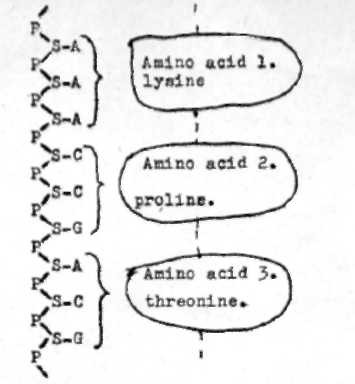
Example of amino acids being linked in accordance
with the sequence coded on a DNA strand.
As well as coding for amino acids, we also need a code for a ‘full stop’, telling the protein machine to stop making the protein and start another.
Here’s a more detailed explanation:
How Many Possibilities?
So how many possibilities are there for the DNA codes? A code consists of 3 letters, each of which is either C, A, T, or G. There are four possibilities for the first letter, and for each of these there is four possibilities for the second one (4×4=16) and for each of these there is four possibilities for the third letter, giving a total of 4x4x4 = 64.
In fact there are only 20 different amino acids, and with the ‘full stop’, we have a total of 21 possibilities that the DNA code must represent. So the codes are grouped together: for example, codes ACT, ACC, ACA and ACG all make the amino acid threonine.
Modern thought on Genetic coding can be found here: https://en.wikipedia.org/wiki/Genetic_code
Seven-Sided Sigil Pair-swaps
To make a seven-sided sigil, mark seven points equally spaced around a circle, and then join the points together with a single line which visits each point once and once only. Here are some examples of the shapes you get:



It turns out that there are exactly 39 different shapes you can get – although they can appear rotated or reflected. Seven-sided sigils appear in a number of the Sareoso diagrams.
The seven-sided sigils have their own relationships and characteristics, and can be categorised in different ways. For example, three of the sigils always look the same no matter how they are rotated or reflected. Another 21 have just one axis of symmetry, and the other 15 have no symmetry.
One way of considering the relationships between different sigils is to consider pair-swaps, where you switch two points on a sigil and see what other sigil results. For example:

The table below shows all the possible pair swap connections between the sigils.
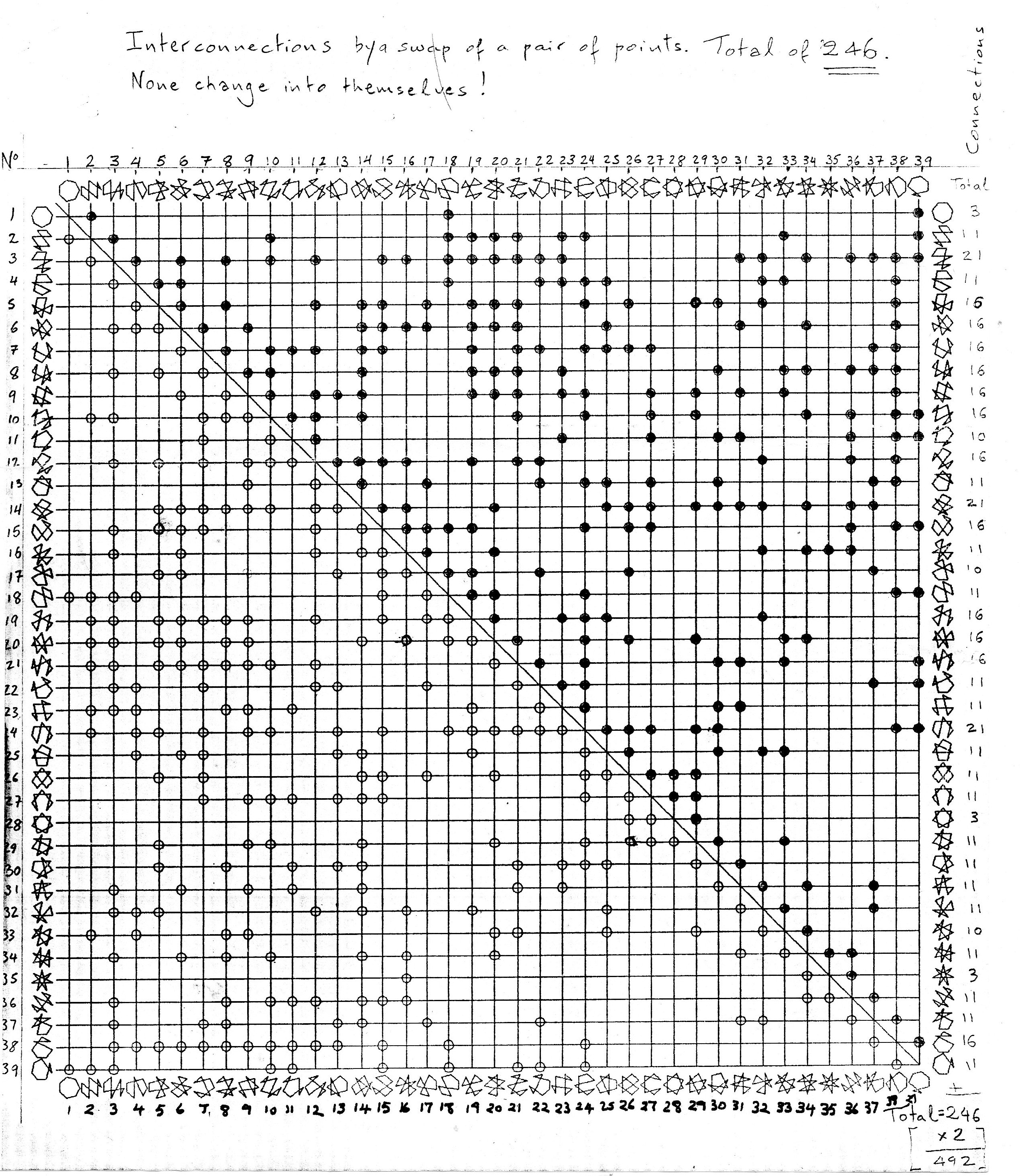
The table is complex, but there are patterns. For example, looking at the right hand side, we can see that there are:
3 sigils that swap to 3 others (9 swaps in total)
3 sigils that swap to 21 others (63 swaps in total)
3 sigils that swap to 10 others (30 swaps in total
18 sigils that swap to 11 others (198 swaps in total)
12 sigils that swap to 16 other (192 swaps in total)
The pair swaps can be used to further categorise the sigils, as discussed in this article.
Basque Dances
Basajaun – the Lord of the Forest
On my first visit to the Basque Country, I stayed in Zubieta, a small village in Navarre. The town is famous for the yearly carnival when the Joaldunak march to the neighbouring village, swinging huge cowbells to wake the world up from winter. Zubieta is in a quiet river valley, and is surrounded by hills and mountains. On the slopes there are woods and pastures where sheep and cows graze.
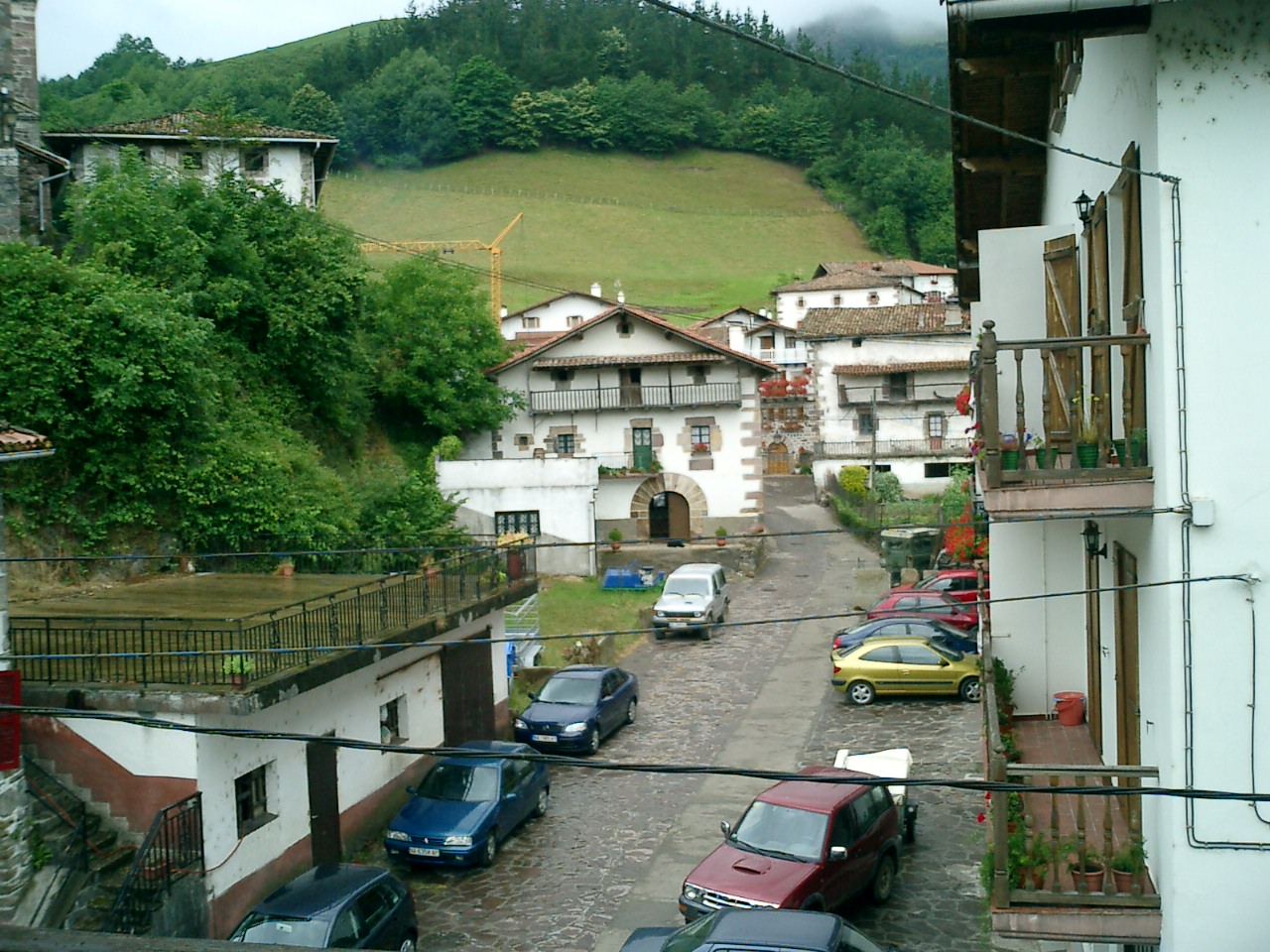
Zubieta street scene
Bells in the Night
At night all is quiet, and very dark except for the occasional street light in the village itself. Every now and then you can hear the bells worn by the grazing animals on the slopes surrounding the village. Most of the time, the bells ring just occasionally, but sometimes there is an outburst of bells ringing. Something is happening up on the hill! Nothing can be seen in the dark, but the bells ring out. I was told that when this happens, it’s because Basajaun, the Lord of the forest, is walking among the animals.
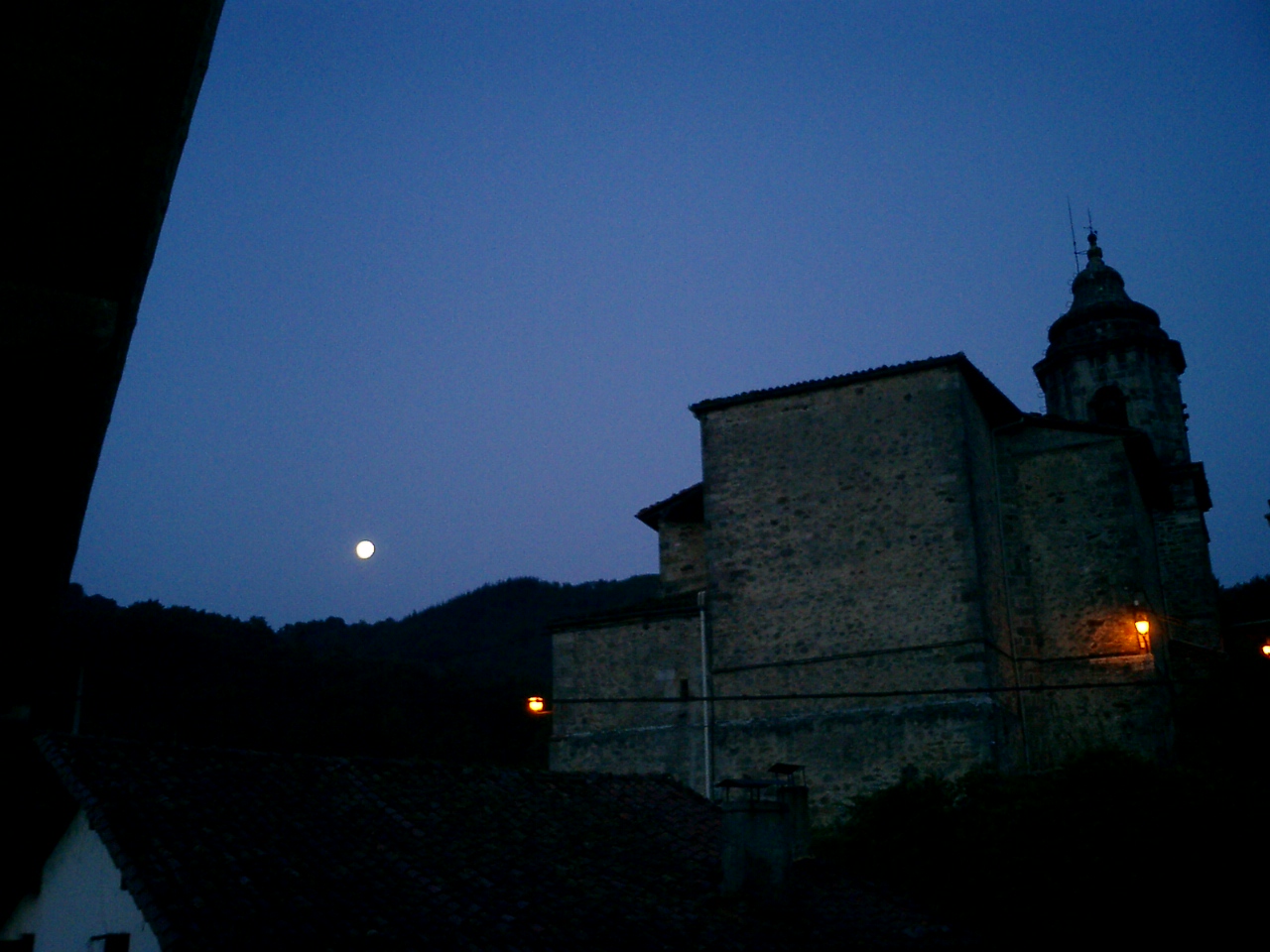
Zubieta at night.
Baxajaun Legends
José Miguel de Barandiarán writes about Baxajaun (the x is used in Basque instead of an s) in his book on Basque Myths and Legends: [1]
“Baxajaun, lord of the forest, is the spirit that dwells in the deepest part of the forests or in caves situated in prominent places. It has a tall body in human form, covered with hair. Its long hair falls forward down to the knees, covering the face, chest, and stomach. It is the guardian spirit of flocks. It cries out in the mountains when a storm approaches so that the shepherds can move their flock into the fold. When Baxajaun is in the vicinity of the fold, there is no danger of the wolf approaching. Its presence is announced by the sheep with a simultaneous shaking and jingling of their bells. Then the shepherds can fall asleep peacefully, knowing that during that night or day the wolf, the great enemy of flocks, will not come around to bother them.”
Barandiarán goes on to say that although Baxajaun is sometimes represented as a frightening creature, of evil character, endowed with colossal strength and extraordinary agility, in other stories he is the first farmer from whom men learned the cultivation of grains and the first blacksmith and the first miller from whom man stole the secret of the making of the saw, the axle for the mill, and the working of metals. He retells some stories on this theme:
The Seeds of Wheat
“In Ataun, they say that the baxajaun grew wheat on Muskia mountain, situated in that town. A brave man—San Martinico—went to visit them in their cavern. Arguing with those spirits, he deliberately fell onto a pile of wheat that was there, filling his albarcas or Basque shoes with grains of wheat. Thus, on returning to his town, he carried in his shoes the seeds of the precious cereal. On discovering this, the baxajaun threw his axe at San Martinico, but he missed and could not prevent the growing of wheat from spreading throughout the world.”
San Martinico (or San Martin Txiki in Basque) mean “Little Saint Martin, and he is a trickster figure, like Prometheus, in Basque Mythology.
There’s a sequel to the story, that although Martin Txiki obtained the seeds of wheat, the villagers didn’t know when to plant them, so Martin went again to the cave of the basajaun, and heard them singing a song:
“Gizakiok balekite abestitxoa
aterako liokete etekin ederra.
Hostoa sortzean erein artoa,
hostoa erortzean erein garia
San Lorentzo garaian erein arbia”“It simply came to our notice then
they would reap a beautiful return.
Sow corn in the leaf,
sow wheat when the leaf falls
Sowing turnips in the time of St. Lawrence “
So he knew that wheat was to be planted in the autumn, at leaf-fall.
You can listen to someone telling the story of Martin Txiki and the basajaun from a children’s book in Basque:
Making a saw
According to a legend from the region of Oiartzun, San Martin Txiki didn’t know how to make a saw, but he knew that the baxajaun had the secret. So he decided to trick the secret out of the baxajaun. He sent a servant to announce in the town that San Martin Txiko had indeed managed to construct a saw. On hearing this, the baxajaun asked the servant, “Has your master seen the leaf of the chestnut tree?”
“He hasn’t seen it but he will,” answered the servant, who later told San Martin Txiki what had happened. This is how the technique for making the saw was spread throughout the world.
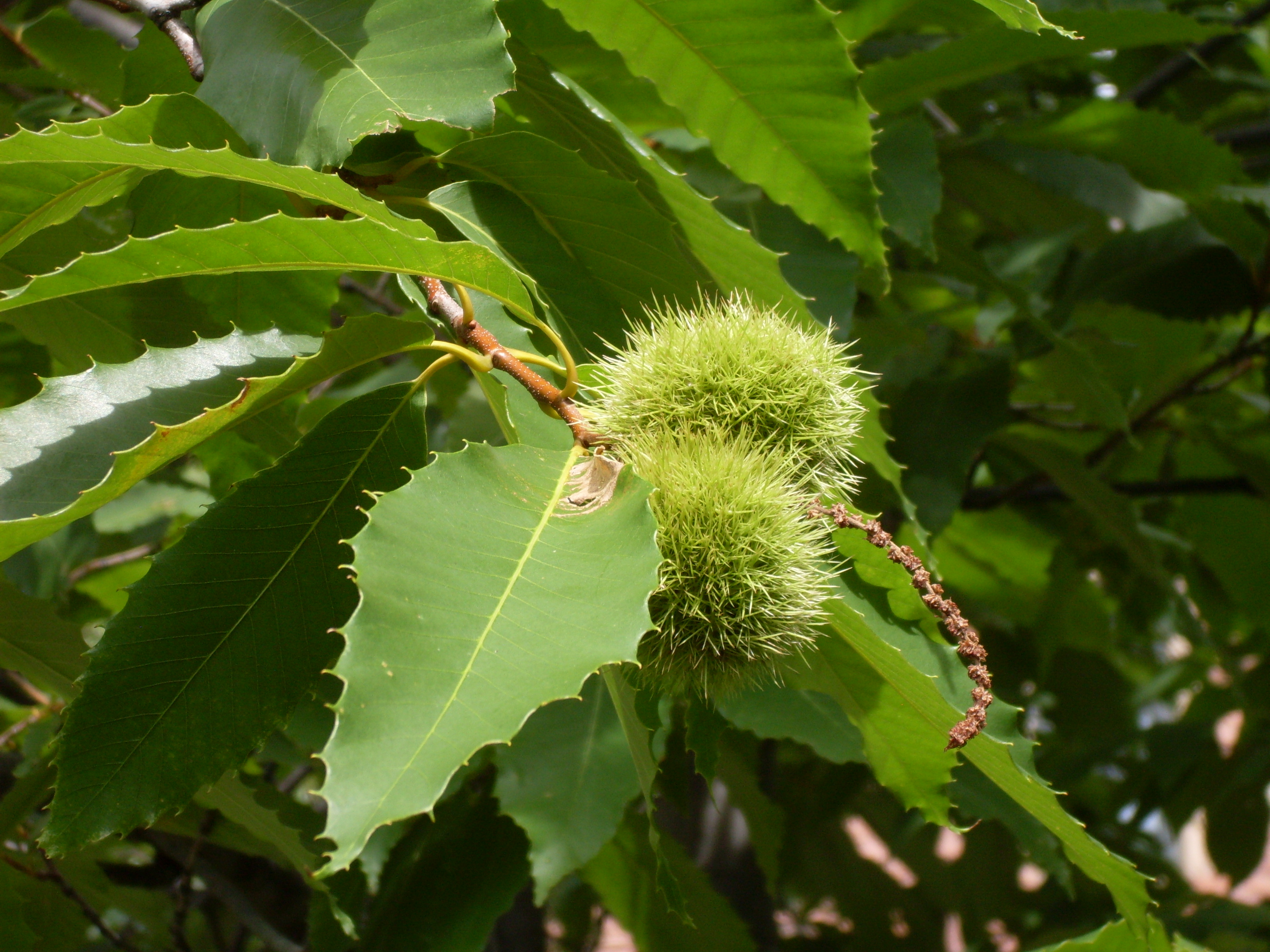
Chestnut (image from Wikimedia commons)
The Secret of Soldering Iron
With the same trick, San Martin Txiki succeeded in learning how the baxajaun soldered two pieces of iron together, according to a legend from Kortezubi. He ordered the herald to announce that he had discovered the process for soldering iron. The baxajaun asked the herald, “Did he sprinkle the pieces of iron with water from potter’s clay?”
“He didn’t, but he will,” was the reply. And as a consequence of this new secret, the technique of soldering iron was spread throughout the world.”
The Mill Axle
A legend from Sara explains that the axle for St. Martin’s mill was made of oak and that when it was used to turn the wheel it burned up. But the axle of the baxajaun’s mill lasted for a long time. San Martín had it announced that his mill now functioned without any interruption.
“That means that he has used an axle made from an alder tree,” replied the baxajaun.
“He is going to use one,” replied the herald. And thus, thanks to San Martin Txiki’s trick, men were able to benefit from the use of the mill all over the world.
Listen in Basque
You can hear about Baxajaun in Basque here.
Who is Basajaun?
Some people see Basajaun as a Basque version of the Yeti or Bigfoot. There are theories that he might depict a Neanderthal man from tens of thousands of years ago when modern man and both Neanderthals lived in the area. [2]
Another possible connection is to the legends of the bears. Basajaun is wild and hairy, like a bear, and in another blog article, there’s a suggestion that there was a time when bears ruled men. Perhaps this was linked to the idea that men obtained the secrets of agriculture and metalwork from a more skilled race.
One other interesting connection is through the Cave of San Juan Xar, an old sanctuary near the village of Igantzi, in the Bidasoa river valley. [3] The sanctuary hosts three springs of healing water. According to Barandiarán, it was Basajaun who first presided over the cave, but today Basajaun is accompanied by a sculpture of a Saint Juan (St John) bearing a cross, turning the cave into a chapel. Every San Juan (23rd June), on midsummer’s night, locals gather here for an evening ceremony. St John the Baptist was a bit of a wild man himself, living in the wilderness, wearing clothes made of camel’s hair, and eating locusts and honey. He was the archetypal ascetic, and he was sometimes called the forerunner, who prepared the world for the coming of Christ.
Modern Legends
Today it seems that Basajaun has taken on a role as a guardian figure for the countryside. There are films showing him sneaking up on littering visitors to the woods, and an interesting modern short film depicts him as a green man figure, defending the woods against exploiters:
Basajaun y las lindes de los Bosques (Basajaun and the borders of the forest).
Notes:
[1] Mitología Vasca, José Miguel de Barandiarán (Txertoa), in Spanish. An English translation is available as part of Selected Writings of José Miguel de Barandiarán: Basque Prehistory and Ethnography. [available as a PDF file here: https://scholarworks.unr.edu/handle/11714/750 ]
[2] Article about Basajaun, and theories that he might originate from the proto-Basque interaction with Neanderthals over 40,000 years ago. https://www.pyreneanexperience.com/basajaun-and-basque-mythology/
[3] Article about the cave of San Juan Xar https://www.pyreneanexperience.com/cure-san-juan-xar/